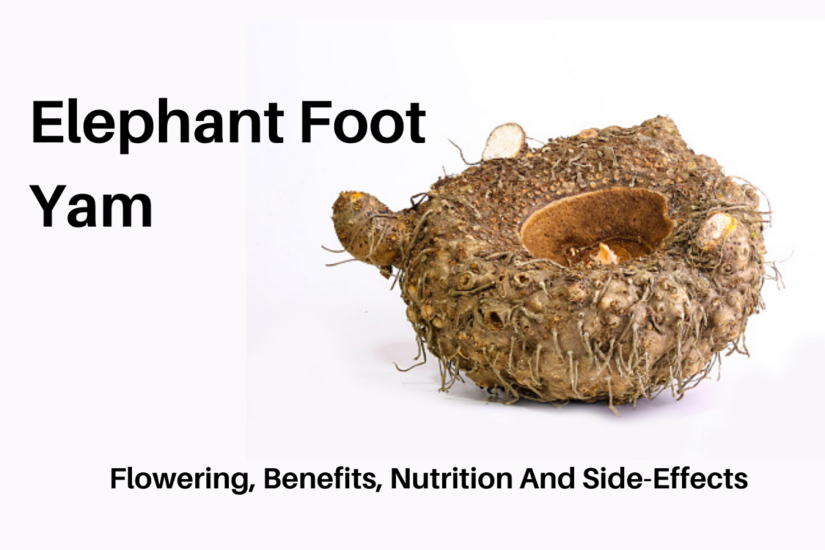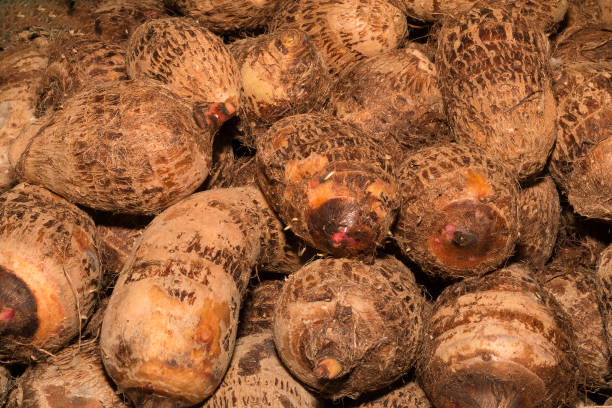Elephant Foot Yam: Flowering, Benefits, Nutrition and Side-Effects

All about Elephant Foot Yam (Amorphophallus paeoniifolius) Side-Effects & Allergies
When it comes to Ayurvedic medicine, elephant foot yam is used to cure many disorders, from the simple like coughs and colds towards the more serious like increasing the sperm’s effectiveness and dealing with problems with the spleen and liver. The tuber can be grown, consumed, and then used to treat haemorrhages and piles.
Asian cuisine benefits significantly from the non-acrid & good cooking qualities of the improved varieties of elephant-foot yam. Among other things, Ayurvedic medicine uses tubers to cure piles, diarrhea, asthma, edema of the lungs, vomiting, & stomach pain. In certain circumstances, it is utilized as nothing more than a purgative. Applying a paste produced from the tuber to the damaged area can help alleviate the symptoms of arthritis.
Yams are solely eaten as a main dish in India, mainly served with cereals. Elephant yam in Hindi is by far the most widely consumed edible kind in India, according to the country’s Food and Agriculture Organization (particularly in South India). Each veggie has its distinct combination of health advantages and culinary uses. Yam is utilized as a replacement when other main foods are in short supply. So, it is sometimes referred to as “famine food.”
Elephant Foot Yam Flowering

Each year, the plant blossoms at the beginning of the rainy season. The stalk of a corm-borne bloom emerges purple, and the inflorescence follows suit. Pistillate & staminate blooms of this plant create a spike, a cylindrical cluster of these two flower types. A foul, stinky mucus attracts pollinating bugs close to the top of an inflorescence, whereas staminate & pistillate flowers are found in the center or base of the panicle. Elephant foot yam seeds are a significant contributor to the nutritional content of this food.
Because of the strong aroma, pollen will be readily accepted by stigmas during the first day of blooming as soon as pollinators arrive & seal the inflorescence.
The spike of the elephant yam flower tries to open on the second day. Pollen can no longer reach the female flower. This inhibits the self-fertilization of sperm from the same flower, enabling emerging bugs to transfer it to other blossoms.

Elephant Foot Yam Benefits
Amorphophallus campanulatus, or elephant foot yam, is a yam or pith of the Amorphophallus campanulatus plant. Indians use it as a staple crop and as a popular veggie. There are several benefits to eating this vegetable, even if it loses the visual attractiveness of other veggies such as spears or broccoli. Dark brown, with a hard, stone-like look, has a bulbous shape. Elephant yam benefits are truly innumerable. Find out why you should eat this Asian healthy food every day by keeping it out of the limelight.
- Jimikand, an astringent with a strong flavour and a hot digestive effect, helps with digestion. By increasing bile formation, thermal action aids digestion by reducing wind & mucus manufacturing. To help you feel more energetic, it also can raise your metabolism.
- Suran and Jimikand include ‘isoflavones,’ which have been shown to aid in the treatment of a wide range of skin problems, including pigmentation, drooping, & roughness. Skin can remain soft and pliable for longer if consumed regularly.
- An ingredient called elephant yam nutrition, or Jimikand, has been shown to improve digestion and help people lose weight. People with bloating, gastrointestinal issues, or IBS may find that this vegetable helps them lose weight.
- Vitamins, enzymes, & phytonutrients can help alleviate many current health issues. Eating this wonder vegetable can help patients suffering from obesity, cardiovascular disease, cancer and diabetes.
Jimikand is an excellent vegetable for girls and boys when they’re still growing up since it promotes and controls hormones. Consequently, they will be able to gain muscle mass and height.

Side-Effects & Allergies
Avoid elephant foot yam for those with respiratory issues, such as bronchitis, strep throat, and colds. In some critical cases, Elephant foot yam side effects are sometimes negligible also. Consequently, foot yam should be avoided by patients to prevent further complications.
There is also a risk of itchiness in the throat and mouth after eating the plant in its natural state. Even expectant mothers can eat elephant foot yam as it has no detrimental impact on their newborn child’s health.
Conclusion
Yams are distinguishable from sweet potatoes because of their larger size and thicker skin. You can’t peel them since they’re cylindrical in size & covered in dark brown skin, which only softens when heated. The true yams may be tough to come by in the United States. Elephant yam in the USA is now obtained from local food stores, as these are always imported from other countries. The best places to look for these are always in markets specializing in foreign or ethnic fare.


![Fix [Pii_email_c742a940ba384394925d] Error](https://anunaadlife.com/wp-content/uploads/2022/01/Fix-Pii_email_c742a940ba384394925d-Error-570x304.png)






Comments are closed.